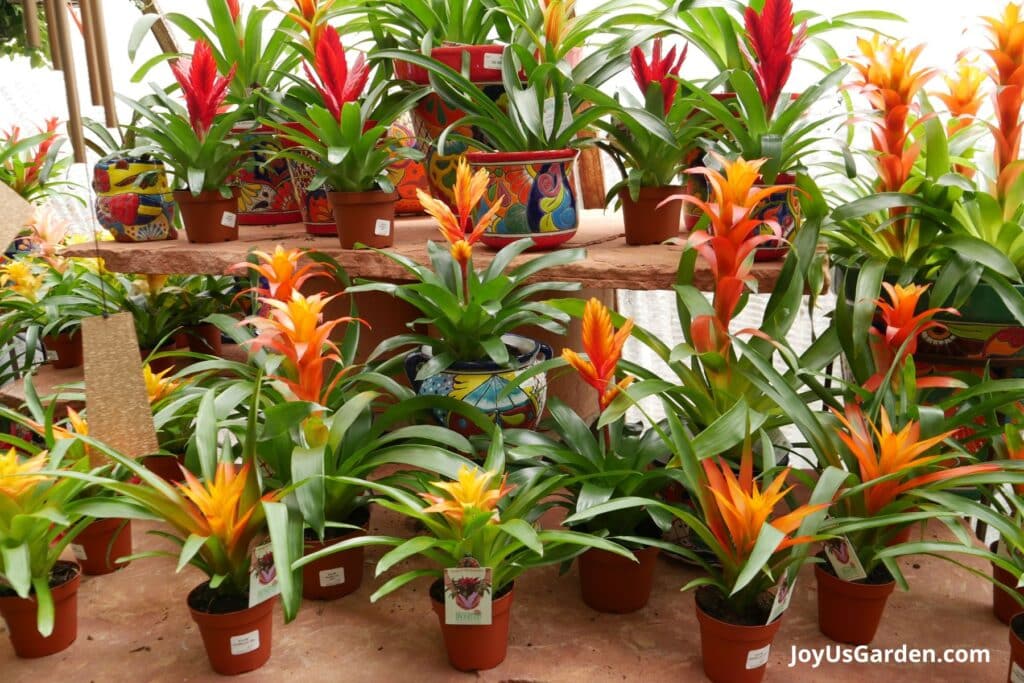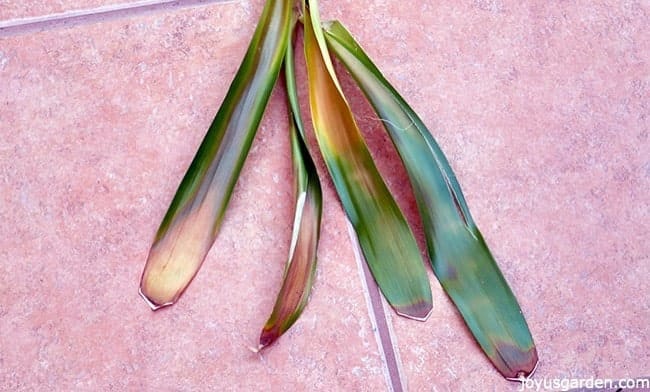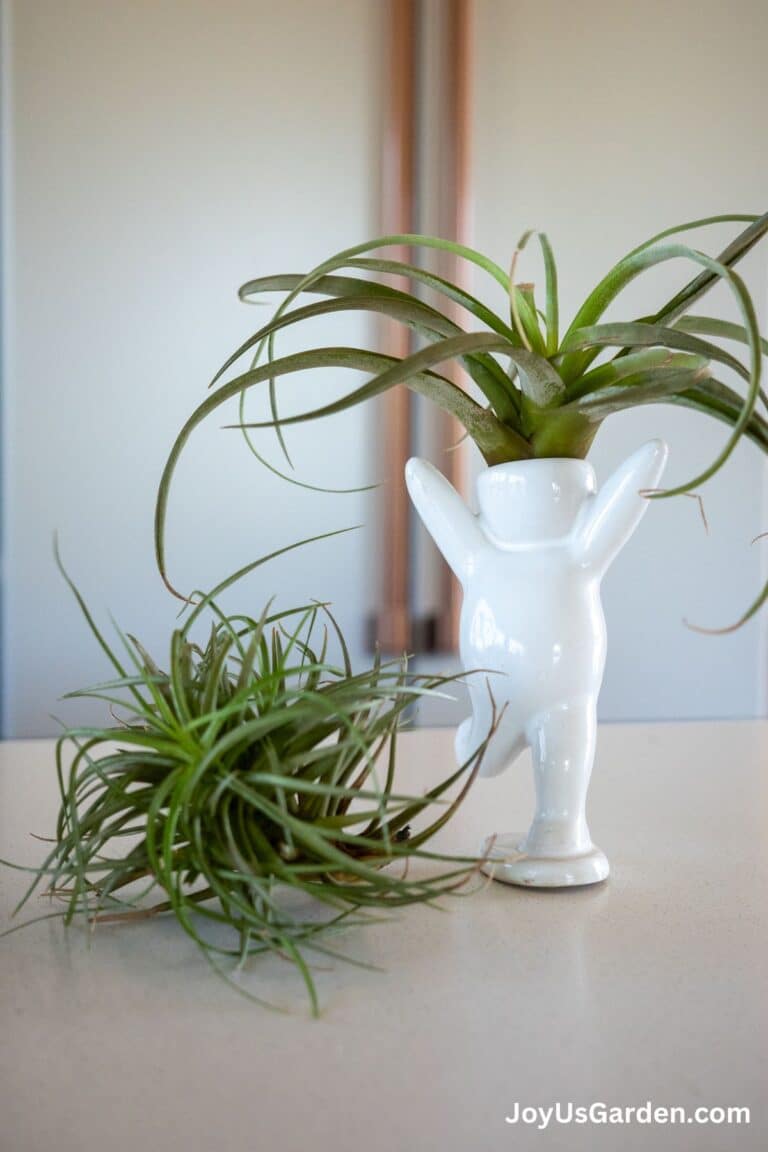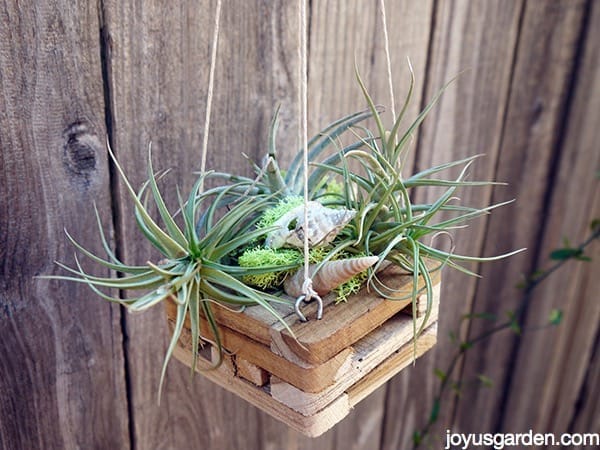Why Is My Bromeliad Turning Brown & Looking Sick?
Bromeliads are popular houseplants because they come in vibrant colors and have unique appearances. I often get asked, “Why is my bromeliad turning brown?” “Why does my bromeliad look sick?” or “Why is my bromeliad dying?” While several potential causes exist, one stands out, and I’ll focus on it here.
I’ve presented this fact before in all the posts and videos I’ve done on bromeliads, but you may have missed it among all the care info. That, along with the fact that my own guzmania was dying out, prompted me to do a post dedicated to this topic!
Note: This was published on 10/14/2017. It was updated on 9/25/2024.

Bromeliad Turning Brown: What It Means & What To Do
What Causes Plants To Turn Brown
Many things can cause houseplants (or plants in general) to turn brown. Here are common reasons: too dry, too wet, too much direct sunlight, a pest infestation (in the case of bromeliads, spider mites or scale insects), or water that is too high in salts and minerals.
If bromeliad leaves are turning brown and/or drooping, it’s most likely a sign that the mother plant is nearing the end of its life cycle. Browning and drooping are natural stages in this process, but they can also be indicators that your plant needs attention or care adjustments.
If the tips of your bromeliad leaves are turning brown, no worries. These beauties are tropical plants so it’s just a reaction to the dry air and low humidity in our homes.
TIP: One way you can be sure your bromeliad is turning brown because it’s dying out is to check the pups that emerge at the base of the plant. If they’re healthy and looking good, then the plant is on the way out. If you’ve kept the growing medium too wet, the lower leaves will turn brown and ultimately mushy.
The Life Cycle Of a Bromeliad
So you’ve brought your beautiful bromeliad home from the store or garden center and found just the right spot. After a few months, the flower starts to turn brown and completely dies, so you cut it off. Eventually, you notice that the plant is slowly turning brown, too. In the case of most types of bromeliads, the leaves tend to bend and droop a bit.
These plants are unique in that they bloom only once, which marks the start of their decline. The bromeliad flowers die first, and then the plant begins to go.
This is part of the bromeliad’s lifecycle: the mother plant dies out, and pups (plant babies) emerge from the base and start their life process. These new pups usually appear before the mother even starts to die out.
Are you wondering what to do with a dying bromeliad flower? Here’s how & when to prune off a dying bromeliad flower.

What You Can Do With A Bromeliad Turning Brown
You have choices: 1) You can cut off the unsightly brown leaves one by one, 2) cut the mother plant back when it starts to turn color, or 3) wait until it’s completely brown and cut it back. It depends on how much the unsightly leaves bother you!
I cut the leaves off my guzmania one by one, and then, when it’s half gone, I cut the mother plant back to the base (you’ll see this in the video). This exposes the pups to more light and gives them room to grow.
If you want to grow the pups, there are a couple of options. You can either leave the pups attached to the base of the mother plant and let them develop that way or remove and pot up the bromeliad pups like I always do.
I wait until they are a good size, at least 5″ or 1/3 the size of the mother, before taking them off so the roots are better developed.
If you want to remove the pups, this tells you how to remove & plant bromeliad pups.
Bromeliads Turning Brown Video Guide
Bromeliad Care – 3 Quick Tips
I’ve done a series on bromeliad plant care, but I want to share three key tips. With the right care, your bromeliad can last for months.
1) They prefer indirect light exposure. They like a good amount of light but not direct sun.
2) Proper watering is important. Keep the central cup (the spot where the flower emerges) one-quarter full of water. If the growing medium is kept too wet, it’ll lead to root rot. Using tap water with high mineral content can cause mineral buildup, so filtered, rain, or distilled water is preferred. I flush out the central cup about once a month to prevent bacterial growth.
3) They prefer a humid environment and warm temperatures.
We’ve written many posts on bromeliad care, including the uber-popular Guzmania & Aechmea. Our Bromeliad Category has lots more information that you’ll find helpful if you’re new to growing these beautiful plants.

Conclusion: So, don’t worry if your bromeliad is dying out like mine in the pictures and video—this is simply part of their natural life cycle. The good news is the pups will carry on the legacy. Just keep in mind that it takes time, usually three to five years, for a pup to reach maturity and bloom again. In this case, patience is key!
That’s why I don’t save and repot every bromeliad pup. Instead, I always keep at least one freshly purchased bromeliad in bloom for that instant burst of color. Bromeliads are easy to find and simple to care for, and their long-lasting flowers brighten any space—so why not add one to your collection?
Happy indoor gardening,


This post may contain affiliate links, you can read our policies here.
- About the Author
- Latest Posts
Nell, the founder of Joy Us garden, was born into a gardening family and grew up in Connecticut’s countryside. After living in Boston, New York, San Francisco, & Santa Barbara, she now calls the Arizona desert home. She studied horticulture & garden design, working in the field all her life. Nell is a gardener, designer, blogger, Youtube creator, & author. She’s been gardening for a very long time & wants to share what she’s learned with you.










Hello I will like to know why my little pink flowers are turning brown… it started too bloom beautifully burñt know the blue flowers disappeared and the pink ones are getting brown
Hi Carmen – The mother plant eventually dies after the plant blooms. Your plant is in the process of dying out. Pups (babies) will appear at the base. Nell
Hi,
I separated three larger pups off of my guzmania mother a few months ago. I potted the three pups separately, and now a center leaf on each pup has a long, light brown lesion on the edge. The lesion on each plant is anywhere from 1-2 inches long and is located about halfway from the tip of the leaf and the base. Is this a sign of root rot from poor drainage? I potted the pups in a standard potting mix. This may be the culprit, but I wanted to get an expert opinion.
Thank you!
Hi Chelsea – Yes, that sounds like too much water. Guzmania are epiphytes meaning they grow on other plants, not in the ground. Potting soil keeps the roots too wet. Nell
Anyway to save one that may have been overwatered? I bought two with yellow blooms in a beautiful container but noticed one was a little limp and turning brown from the bottom. Should I repot it or say my goodbyes now?
Mic – It’s hard to say but probably not. They don’t like to have their feet kept constantly wet. Nell